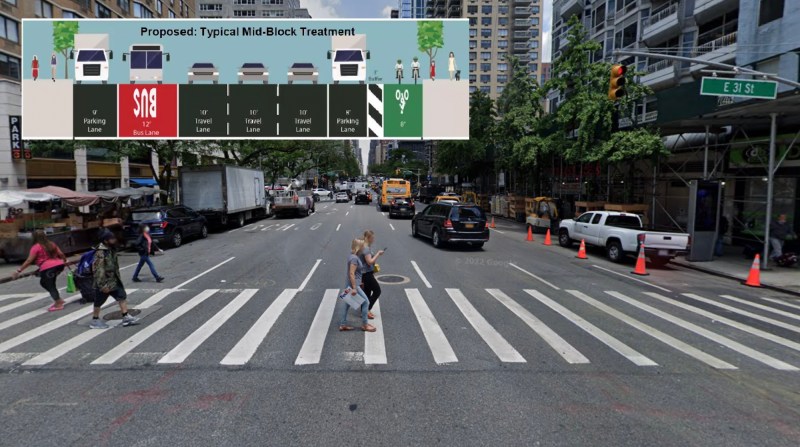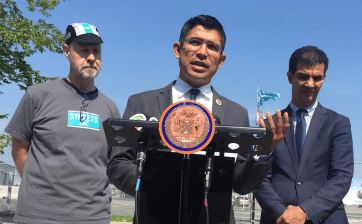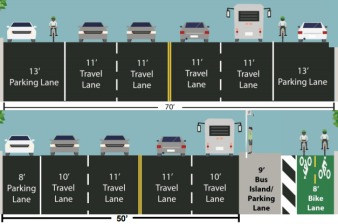Advocates Like (But Don’t Love) the DOT’s Third Ave. Redesign

Hey, DOT — 2010 called and it wants its street redesign back.
An Upper East Side community panel on Wednesday applauded the city for redesigning deadly Third Avenue — a seven-lane car sewer that offers no quarter for bus riders, pedestrians and cyclists — to include dedicated bus and bike lanes, but many members of the panel as well as street safety activists lamented that the plan could still be more ”ambitious.”

Why would they be complaining of a lack of ambition? For one thing, the design presented last week to be built next year is almost identical to what the city did on First Avenue under then-Mayor Mike Bloomberg in 2010.
Both roadways are 70 feet wide. The plan for First Avenue repurposed 22 feet for cyclists and bus riders. The plan for Third Avenue between E. 59th and E. 96th streets that was presented last week repurposes 23 feet for cyclists and bus riders (the extra non-car 12 inches are in the bus lane).
Twelve years and a bike boom later and Third Avenue gets basically what the city built on First and Second avenues — where the bike lanes are already dangerously overcrowded.
In addition to failing providing a truly revolutionary streetscape design that incorporated the bus and bike lane into something new, the city DOT did not even widen the sidewalks to give pedestrians some benefit.
“Widening the sidewalks is a missing component,” said urban planner Mike Lydon, who recently created renderings of what streets could look like in the future — if New York City had political will (see slides below). “Taking one more lane of traffic to give back to pedestrian space would have enhanced the proposal.”
The redesign won the endorsement of Community Board 8’s Transportation Committee, as well as Upper East Side Council Member Keith Powers and Manhattan Borough President Mark Levine, but the Beep is calling on the city to go further by adding more pedestrian space and loading zones in order to mitigate the massive spike in deliveries and congestion.
“The redesign’s commitment to expanded protected bike lanes and dedicated bus lanes will turn this particularly dangerous stretch of the roadway into a safer, more efficient, and forward-thinking artery for all commuters on this key east-side transit corridor,” Levine said in a statement to Streetsblog. “I also hope the city will use this opportunity to identify locations for badly needed loading zones in the streetscape.”
3rd Ave on the Upper East Side is a dangerous stretch—with 6 pedestrians & 1 cyclist killed since 2016.@NYC_DOT has proposed a redesign to make this street safer for all users, and I strongly support it. (And it can be made even better, e.g. with additional pedestrian space) https://t.co/Cz3KfUDjDr
— Mark D. Levine (@MarkLevineNYC) October 13, 2022
The eight-foot-wide bike lane proposed for Third Avenue is two feet wider than the ones on adjacent First and Second avenues, but with the cross-hatched buffer, the room for cyclists remains 11 feet. That amount of space has proven to be outdated. Cars and trucks barely outnumber bikes, despite drivers getting almost 12 times as much space, according to a Streetfilms count last year. Neighborhood residents’ seemingly insatiable tastes for delivery food fills the bike lanes with workers and commuters.
“The lesson we learned from Second Avenue [is] we need wider lanes,” Lydon said.

At issue is whether the Department of Transportation is truly redesigning roads to encourage a mode shift to bikes that it claims it is seeking. Presenting a redesign plan for 2023 that is almost identical to one presented in 2010 suggests that the city is not building for the city that is claims to want, but merely for the city that it currently has.
Speaking in a different context about Paris’s Covid-encouraged bike boom, Kate Fillin-Yeh of NACTO, the organization of city transportation officials, told Streetfilms that part of Vision Zero is having the vision.
“One of the big things is to build for the volumes we want,” she said in a Streetfilms video. “We spend a lot of time building for the volumes we have, and we end up with decent, but still-not-wide-enough lanes in a lot of places. … With the Paris example, they have built for the city they want to see, they have prioritized and made it absolutely the easiest choice to take the metro, to bike, to walk.”
Even the design firm that helped dream up a wholly reimagined Third Avenue in New York Magazine’s Curbed last year was also cautious to embrace the city’s plans, calling them “light-touch improvements” that will hopefully lead to a more robust redesign.
“The Department of Transportation’s plans for Third Avenue represent an important incremental step in reclaiming Manhattan’s avenues as thoroughfares for people rather than arteries for traffic,” said David Vega-Barachowitz, associate principal and director of urban design and the architecture and design firm WXY. “These light-touch improvements help pave the way for a more multi-modal, pedestrian-focused street that celebrates Third Avenue’s potential as a public space.”
Other advocates are hoping this plan is just a jumping off point for even more. Neither First nor Second avenues has been dramatically altered since being redesigned, but the city did come back with revisions. On Second Avenue, DOT replaced dangerous mixing zones with safer offset crossings, and just recently filled in the gaps in the bike lane between E. 43 and E. 34th streets.
“Third Avenue needs more space for people and less space for cars — and DOT’s plan delivers with new bus lanes and a protected bike lane,” said Anna Melendez, Manhattan Organizer for Transportation Alternatives. “As this plan moves forward, we urge DOT to include physical protection for bike riders and pedestrians, wider sidewalks, and new loading zones to tackle dangerous double-parking.”
https://twitter.com/measuredworks/status/1580337623381352449?s=12&t=oEmcBz6TfRbfWngM5vKQmA
The proposal will be heard by the full Community Board 8 on Oct. 19, and as standard and unambitious as some say the plan is, the backlash has already begun.
“It’s never enough for the bike lane people. Now they want two bike lanes, we were just getting one,” said Andrew Fine, vice president of the E. 86th Street Association, during the meeting on Wednesday. Fine did acknowledge the importance of protected bike lanes, but said that there would be plenty of space for all road users if the city actually enforced its traffic laws.
“I think protected bike lanes are great, protection is key. However, the idea of putting a protected bike lane on Third Avenue would be much more palatable if we could somehow commit to actually enforcing traffic laws. Everyone’s double parking, the trucks are everywhere. If we enforce traffic laws there is room for everybody,” he said.
And that’s where the need for loading zones come into play, advocates said.
The DOT says the design is just a start and is slated to break ground next year, but Nick Carey, the lead engineer of the DOT’s bicycle unit, couldn’t elaborate on what those future changes or additions would look like.
“I don’t think that anything we’re proposing is the end of Third Avenue, it’s not the final design, where after that, it’s all done,” he said.

But unlike Second Avenue now, the city’s plans for Third Avenue do not include installing any physical materials other than paint and plastic, a decision that could have deadly consequences for pedestrians.
“We need to harden the pedestrian islands. Paint and plastic is really not enough,” said Upper East Sider Peter Chowla. “We have on Second Avenue curbs on those pedestrian islands and those are really important and really helpful to pedestrians to stay safe with speeding traffic.”
Carey managed to find the silver lining in the design’s lack of more physical protection, like concrete or jersey barriers.
“As much as I want to downplay that we’re talking about temporary materials like paint, that’s what this is. So nothing we’re doing would preclude further improvements in the future.” he said.
Carey said it’s not an “impossibility” that the city would take away another lane of moving traffic from cars and give it to bus riders or cyclists, but that it’s not currently “part of this proposal.”

